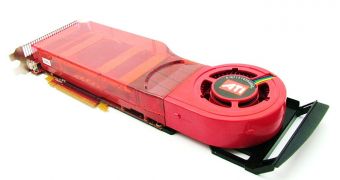AMD's plans for their new line of products are changing day by day, or better said, we've come over an increased array of information, and we are only allowed to see bits and pieces from a very big matrix. The line of video cards AMD is going to launch on the 23rd and 24th of April has gotten a, yet another, set of names; they will be known as the HD 2000 series.
R600-based products will be known as the ATI Radeon HD 2900-series, and it is said to have 320 stream processors. This is quite interesting because the first time I've heard about the R600, it was said to have 64 stream processors, but with each stream processor being able of processing four operations in a single pass, while NVIDIA's G80 stream processors only could do it once at a time. Things have now changed, with the 320 stream processors, even if they do one operation at a time, they still leave NVIDIA trailing behind, way behind.
There has also been talk of the G80 series, that their 8800GTX doesn't have 128 stream processors, but 160, and the rest haven't been "activated" waiting for the right moment to do so. On the HD 2000-series, the stream processors are coupled with a 512-bit memory interface spanning on eight channels. The cards also supports 128-bit HDR rendering, 24x anti-aliasing and apparently they have a physics processing unit, along side the integrated sound card with 7.1 channels and HDA support.
The RV630-based series of video cards will be known as the ATI Radeon HD2600 (Pro and XT) and RV610-based cards will be known as the ATI Radeon HD2400 (Pro and XT) series. All of the cards in the HD 2000-series will feature Avivo HD, an upgrade from the AVIVO found on the x1000 series, which has an Universal Video Decoder included, as well as an Advanced Video Processor.
AMD is also "attacking" the competition with new processors, other than the ones expected to launch this month, and the target is, of course, Intel Corporation. AMD is trying to undermine Intel's Santa Rosa platform, by releasing on the 6th of May a faster Turion processor, the AMD Turion 64 X2 TL-66. The processor in built on the 65nm process node, will feature a 2.3GHz clock speed, 512KB x 2 L2 Cache, support for DDR2-800 dual channel memories and a TDP of 35W. In addition to this, AMD will switch four existing processors to the 65nm process node, they are the Turion64 X2 TL-64 (2.2GHz/512KB L2 x 2/35W TDP), TL-60(2.0GHz/512KB L2 x2/31W TDP), TL-58(1.9GHz/512KB L2 x2/31W TDP), and TL-56(1.8GHz/512KB L2 x2/31W TDP).
AMD's K10 architecture and the Barcelona "native quad-core" processor are thrown into battle against Intel's Clovertown processors, with high hopes and expectations from AMD regarding the technological superiority they posses with this model over Intel's offerings. Some schematics of the processors inner workings have become available on the Internet, and they reveal features such as Nested Paging, designed for "near native performance on virtualization applications", advanced power management, enhanced integrated DRAM controller and a "highly efficient cache structure including a shared L3".
Barcelona will have four cores on a single die, each with their own independent L1 and L2 caches (512KB cache each) and a shared 2MB L3 cache. The processor cores will interface with the system memory and peripherals through a crossbar switch, allowing it to have greater performance than Intel's quad-core processors, which has two dual-core processors linked together through a Multi Chip Module, which in term communicates to the systems memory through the FSB.
The Sunnyvale-based company is ready to bring out the big guns, and they are taking each segment of the market with a line of products that offer a great deal of performance, on paper at least, that is, for the time being. On the graphics part of the deal, AMD's R600 will have features that will make a lot of people in the entertainment business very happy. It seems that the R600 chips will "block unauthorized access to the frame buffer", not allowing individuals to "save the contents of the display to a file on disk unless the content owner approves it." Access to that frame buffer will be granted to companies such as Microsoft, Apple, AMD, Intel, ATI, NVidia, Sony Pictures, Paramount, HBO, CBS, Macrovision and others, but not to the home user, being a method that wants to stop piracy from taking place.
It is a good intention from their part, with one minor glitch in their plan, what can be done, can be undone, and it will only be a matter of time before this "password" gets cracked. It also is apparent that what I was talking about just yesterday, about cards miraculously appearing on different websites, well, such is the case with a stray R600, which ended up on FX57.net. The guys tested the card using an Intel Core 2 Duo X6800 processor, a i975-based motherboard, 2GB DDR2-800 memory and ATI Catalyst 7.1 (8.33) as well as NVIDIA ForceWare 97.44 and ended up with these results. The R600XTX scored 12000 points in 3DMark06, and the R600XT model scored 10000 points.

 14 DAY TRIAL //
14 DAY TRIAL //